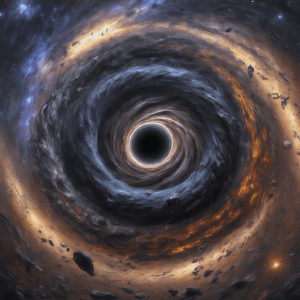Table of Contents
Gravity is a fundamental force of the universe, governing the motion of celestial bodies and maintaining the structure of galaxies. A deeper understanding of gravity leads us to one of the most fascinating and enigmatic phenomena in the cosmos – black holes. These are regions in space where gravity’s pull is so strong that nothing, not even light, can escape its grasp. In this article, we’ll explore the intricate physics behind black holes, their formation, and the incredible effects they have on their surrounding environments.
The Birth of a Black Hole
The birth of a black hole is an event of incomprehensible violence and beauty. These celestial entities are born from dying stars in a process known as supernova explosion. When a star more massive than our Sun exhausts its nuclear fuel, it collapses under its own weight and explodes, ejecting most of its mass into space. However, if the core mass that remains is about three times the mass of our Sun or greater, no force can resist its gravitational pull. The core collapses to form a black hole.
Stars with a lesser mass don’t become black holes when they die. Instead, they become white dwarfs or neutron stars. Each stellar death contributes to the complexity and richness of the cosmos, either through dispersing elements into space for new stars and planets to form or creating extraordinary gravitational phenomena like black holes.
The Anatomy of a Black Hole
Black holes are so much more than just dense points in space. They possess fascinating features that continue to puzzle physicists worldwide. At the center lies the ‘singularity,’ a point where density becomes infinite and space-time curves infinitely. Essentially, the laws of physics as we know them cease to apply.
Surrounding the singularity is the ‘event horizon,’ aptly named because any event that occurs within this boundary is forever hidden from an outside observer. The event horizon is the point of no return, beyond which the gravitational pull becomes so strong that escape is impossible, even for light. Outside the event horizon, black holes can have an ‘accretion disk,’ a swirling disk of matter that’s slowly spiraling into the black hole.
Black Holes and the Fabric of Space-Time
Black holes don’t just swallow matter and light; they also twist and warp the fabric of space-time around them. This is what gives rise to phenomena like gravitational lensing, where the path of light from a distant object is bent when it passes near a black hole, causing the object to appear distorted or magnified to an observer.
Black holes can also create gravitational waves – ripples in the fabric of space-time caused by the acceleration of massive objects. When two black holes orbit each other and finally collide, they can send out gravitational waves powerful enough to be detected here on Earth.
Conclusion
Understanding black holes requires a leap into realms where our normal physical intuitions are dramatically defied. They are not just objects in space but profound cosmic enigmas, challenging our understanding of space, time, and matter. As we continue to study these mysterious entities, we find that they are not just dead ends but rather gateways to further discovery, holding secrets that may reshape our understanding of the cosmos.
